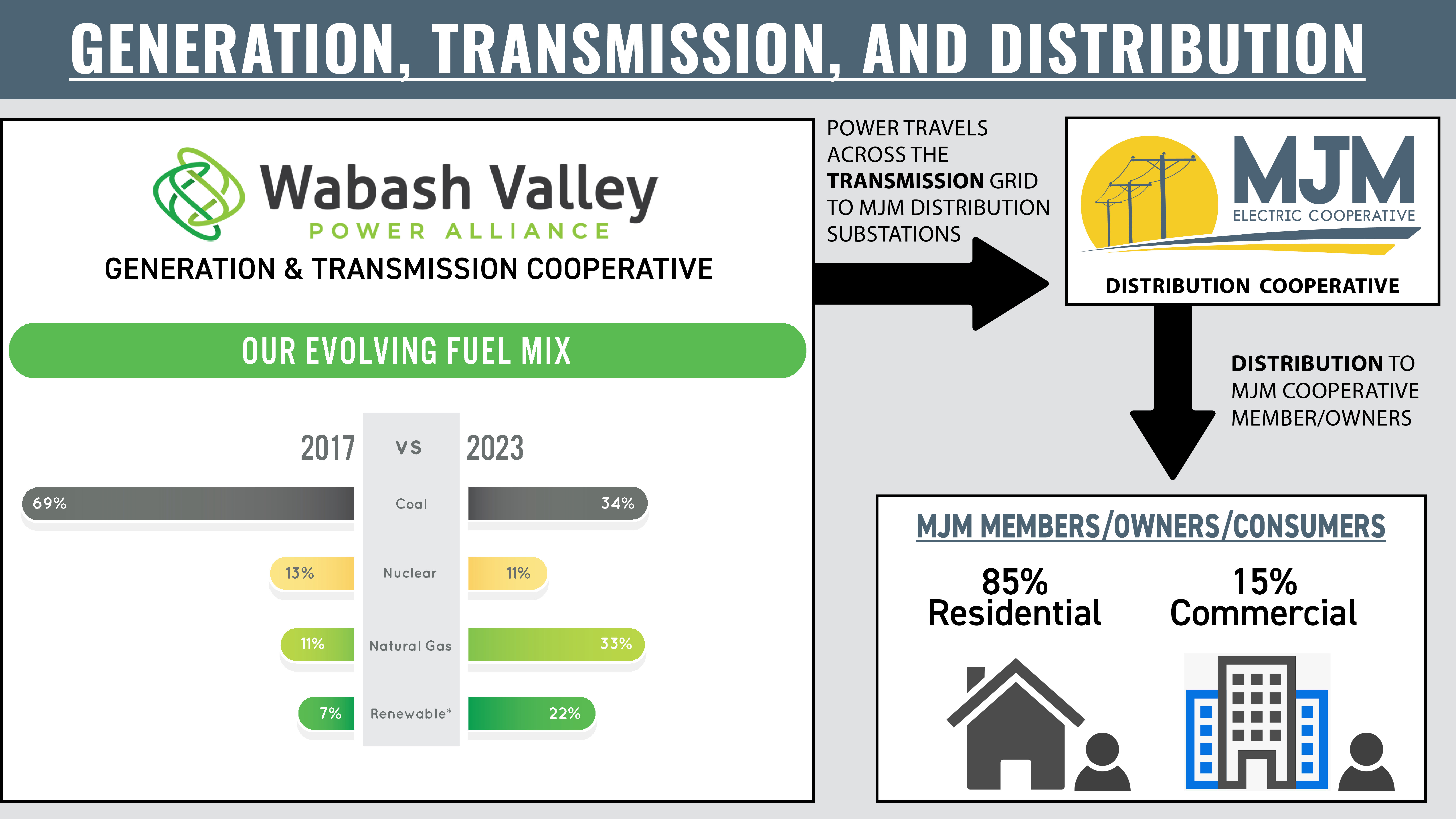The Electric Cooperative Story
Frequently Asked Questions
Anyone who pays a $5 membership fee, pays a meter deposit and receives electrical service from MJM Electric is a member of the cooperative. Each member owns a little piece of the cooperative. Since MJM is a not-for-profit company, members don’t make money off its services but do have a say in how the cooperative operates.
All members are invited to attend the cooperative’s annual meeting. The state of the cooperative will be discussed at this meeting, and members can directly affect the operation of the cooperative by voting for directors on a one-member-one-vote basis.
No, MJM is a distribution cooperative.
MJM constructs and maintains the power lines and substations necessary to deliver power to their rural members but does not generate that power. MJM purchases its power wholesale from Wabash Valley Power Alliance (WVPA) in Indianapolis, Indiana. WVPA is a cooperative organization that has an alliance with more than 20 member distribution co-ops. WVPA makes and transmits the electricity from the power plants to MJM for distribution to our Members. (see infographic below)
MJM Electric Cooperative and other electric cooperatives across the nation were born out of the idea that rural citizens deserved the same quality of life as people from the city. In the 1930s, investor-owned utility companies were reluctant to provide electricity to farmers and other folks from rural areas. In cities and large towns, building one stretch of power lines might reap profits from dozens of customers, but building a stretch of power lines in the country all the way out to only one or two houses meant much less profit. Investor-owned companies would either refuse service for these areas or charge them huge fees and higher power costs than they did for city-dwellers. As a result, only 10 percent of rural American homes had electricity back then. And yet, President Franklin D. Roosevelt recognized how electricity could increase farm productivity and improve the lives of rural Americans. As part of his New Deal program to end the Great Depression, he established the Rural Electrification Administration (REA) on May 11, 1935 to promote the spread of electricity to these areas.
Farmers banded together to form their own communally-owned, not-for-profit electric cooperatives, but these groups usually lacked the resources to construct lines and purchase equipment. The Rural Electrification Act of 1936 allowed the REA to provide these cooperatives with money in the form of low-interest federal loans. By 1938, there were already two fledgling cooperatives signing up members in Macoupin and Montgomery counties: Rural Electric Convenience of Divernon and Illinois Rural of Winchester. But in early 1939, it became apparent that Winchester’s diesel power plant was not going to be able to provide enough power to all of Macoupin County, leaving farmers in the southern part of the county unsure of their future. Macoupin County farm advisor O.O. Mowery had been heavily involved in plans for the electrification of the area. After a meeting with neighboring farm advisors and the REA, it was decided that another cooperative needed to be established to meet the people’s needs.
MJM was first officially organized on April 5, 1939, and the first official meeting of the board of trustees was held on April 10 at 2 p.m., in Mowery’s office in Carlinville. The name was suggested by Loren L. Love of Carlinville and stands for Macoupin, Jersey, Montgomery – the three counties initially served by the Cooperative. Love, who served as the Cooperative’s first treasurer, was instrumental in signing members up for service. Before the creation of MJM, he was paid $3 a day to sign up members and obtain easements. His gasoline and vehicle expenses came out of that pay. There were many other men and women like Loren Love who poured their time and energy into bringing electricity to the rural community of west central Illinois. The end result was well worth it. One member, a middle-aged woman in Macoupin County, actually cried when she turned on the light switch for the first time. Electricity meant she would no longer have to wash clothes by hand or bring in firewood for the stove. When the Cooperative officially formed in 1939, it counted 940 members in Macoupin, 250 in Montgomery, and 410 in Jersey.
The board of directors signed a contract with Iowa-Illinois Power Company to secure a source of electricity, and the Cooperative’s first member had power turned on in 1940. The average member, in 1941, used an average of 79 kilowatt hours a month. Your Cooperative now provides electricity to more than 9,400 accounts and services 2,115 miles of power lines through Macoupin, Jersey, Montgomery, Bond, Fayette, Green, and Madison counties. The average member uses about 1,200 kilowatt hours per month. In 2002, MJM signed a power-purchasing agreement with Wabash Valley Power Alliance in Indianapolis. That same year, MJM became a member of Touchstone Energy, a support organization that counts more than 750 cooperatives across 46 states as members. It is still less profitable to provide electricity for low-population areas than it is for cities, but we keep our costs as low as possible by being a not-for-profit organization. Just like in the 1930s, we do not aim to turn a large profit but to provide our member-owners with quality service. Your money isn’t going into the pockets of wealthy investors; it pays for what it costs us to deliver electricity to you and keep our lines in working order, with a little bit set aside to help the community.
~ Written by Erin Pennington, former MJM Member Services Coordinator

